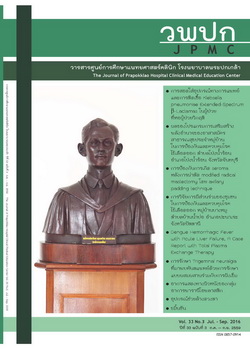การสอดใส่อุปกรณ์ทางการแพทย์และการติดเชื้อ Klebsella pneumoniae Extended-Spectrum β-Lactamases ในผู้ป่วยที่หอผู้ป่วยวิกฤติ
Main Article Content
Abstract
บทนำ: โรคติดเชื้อแบคทีเรียที่เกิดจากเชื้อ K. pneumoniae เป็นปัญหาสำคัญในประเทศต่างๆทั่วโลก ซึ่งเชื้อแบคทีเรียชนิดนี้มีอัตราการดื้อยาต้านจุลชีพเพิ่มสูงขึ้น การดื้อยาต้านจุลชีพของเชื้อ K. pneumoniae ที่เป็นปัญหาสำคัญและพบได้บ่อยคือการดื้อต่อยาต้านจุลชีพในกลุ่ม Extended-Spectrum β-lactamases
วัตถุประสงค์: เพื่อศึกษาความสัมพันธ์ระหว่างการสอดใส่อุปกรณ์ทางการแพทย์และการติดเชื้อ Klebsella pneumoniae Extended-Spectrum β-Lactamases ในผู้ป่วยที่เข้ารับการรักษาที่หอผู้ป่วยวิกฤติ
วิธีการศึกษา: รูปแบบการศึกษาแบบกลุ่มศึกษาและกลุ่มควบคุม (อัตราส่วน 1: 2) โดยใช้ฐานข้อมูลจากโรงพยาบาล ซึ่งดำเนินการเก็บข้อมูลประวัติการรักษาผู้ป่วยย้อนหลังจากเวชระเบียนของผู้ป่วยที่เข้ารับการรักษาในโรงพยาบาลร้อยเอ็ดระหว่างวันที่ 1 มกราคม 2557 ถึง วันที่ 31 ตุลาคม 2558 โดยสถิติที่ใช้ในการวิเคราะห์ข้อมูลได้แก่ สถิติเชิงพรรณนา การวิเคราะห์ตัวแปรเชิงเดี่ยว และการวิเคราะห์ ตัวแปรเชิงพหุ
ผลการศึกษา: กลุ่มศึกษาเป็นผู้ป่วยที่ติดเชื้อ KPESBL จำนวน 40 ราย ส่วนมากเป็นเพศชายร้อยละ 57.5 อายุเฉลี่ย 65.1 ปี กลุ่มควบคุมซึ่งเป็นผู้ป่วยที่ไม่ติดเชื้อ KPESBL จำนวน 80 ราย ส่วนมากเป็นเพศชายร้อยละ 51.3 อายุเฉลี่ย 52.5 ปี ผลการวิเคราะห์ข้อมูลโดยใช้สถิติพหุถดถอย พบปัจจัยที่มีความสัมพันธ์ต่อการติดเชื้อได้แก่ ผู้ป่วยมีอายุมากกว่า 60 ปี (OR Adj.= 2.9 :95%IC; 1.30-6.35) ผู้ป่วยที่นอนในหอผู้ป่วยวิกฤตินานมากกว่า 7 วัน (OR Adj.=3.6 :95%IC; 1.34-9.42) ผู้ป่วยที่มีประวัติการได้รับเลือด (OR Adj.= 2.5 :95%IC; 1.11-5.66) ผู้ป่วยที่ได้รับการปฏิบัติการช่วยฟื้นคืนชีพ (OR Adj.=3.9:95%IC; 1.14-13.94) ส่วนปัจจัยเสี่ยงด้านการทำหัตถการและสอดใส่อุปการณ์ทางการแพทย์เข้าสู่ร่างกายได้แก่ ผู้ป่วยที่ได้รับการผ่าตัด (OR Adj.=3.2:95%IC; 1.32-8.16) การใส่สายสวนปัสสาวะ(OR Adj.=3.0:95%IC; 1.26-7.24) การใส่สายสวนหลอดเลือดดำส่วนกลาง (OR Adj. =3.9:95%IC; 1.09-13.77) การใส่ท่อช่วยหายใจ (OR Adj. =5.1:95%IC; 1.76-14.72) การใส่เครื่องช่วยหายใจ (OR Adj. =5.8:95% IC; 2.00-16.62) การทำ cut down (OR Adj. =6.2:95%IC; 1.75-61.62) และการเจาะคอ (OR Adj. =2.8:95%IC; 1.16-7.07)
สรุป: ผู้ป่วยที่เข้ารับการรักษาที่หอผู้ป่วยวิกฤติเป็นเวลานานและได้รับการรักษาด้วยการสอดใส่อุปกรณ์ทางการแพทย์ต่างๆเข้าสู่ร่างกายจะมีความเสี่ยงต่อการติดเชื้อ KPESBL ซึ่งผู้ป่วยกลุ่มนี้ควรที่จะมีมาตรการเฝ้าระวังเป็นพิเศษเพื่อป้องกันการติดเชื้อ
คำสำคัญ: หอผู้ป่วยวิกฤติ, อุปกรณ์ทางการแพทย์, Klebsella pneumonia, Extended-Spectrum β-Lactamases
Medical Procedures and Klebsella pneumoniae Extended-Spectrum β-Lactamases Infection among Patients in Intensive Care Unit
Background: The bacterial infection caused from K. pneumoniae is a majority problem worldwide. These pathogens are frequently resistant to antibiotics. The antibiotic resistant these pathogens have become a serious problem and frequently found resistant to Extended-Spectrum β-lactamases.
Objective: To investigate the association between medical procedures and Klebsella pneumoniae Extended-Spectrum β-Lactamases (KPESBL) infection among patients who were admitted in the intensive care unit.
Material and Methods: A hospital based case control study (Case: Controls =1:2) and data were collected from medical records. All patients were admitted in the intensive care unit (ICU) of Roi Et hospital, Roi Et province between January 1, 2014 to October 30, 2015. Data analyses were used descriptive statistics, univariable analysis and multivariable analysis by multiple logistic regressions.
Results: All 40 cases were with KPESBL infected, most of them were male 57.5 % mean age 65.1 years and 80 controls were without KPESBL infected, most of them were male 51.3% mean age 52.5 years. The multivariable analysis showed the risk factors of KPESBL infection among patients in ICU were patients age more than 60 years old (OR Adj.= 2.9 :95%IC; 1.30-6.35), admitted more than 7 days(ORAdj.=3.6 :95%IC; 1.34-9.42), blood receive (OR Adj.= 2.5 :95%IC; 1.11-5.66) and cardio-pulmonary resuscitation(OR Adj.=3.9:95%IC; 1.14-13.94). The invasive medical procedures were statistically significant with patients underwent with surgeries (OR Adj.=3.2:95%IC; 1.32-8.16), urinary catheterization (OR Adj.=3.0:95%IC; 1.26-7.24), central line (OR Adj. =3.9:95%IC; 1.09-13.77), endotracheal tube (OR Adj. =5.1:95%IC; 1.76-14.72), ventilator (OR Adj. =5.8:95%IC; 2.00-16.62), cut down (OR Adj. =6.2:95%IC; 1.75-61.62) and tracheostomy (OR Adj. =2.8:95%IC; 1.16-7.07).
Conclusion: The medical procedures were the factors, which were associated with KPESBL infections among patients were admitted in the intensive care unit. All patients who have long time admitted and underwent with invasive medical devices should have special guideline for them.
Keywords: Intensive care unit, Medical procedure, Klebsella pneumonia, Extended-Spectrum β-Lactamases
